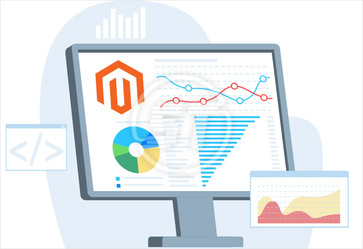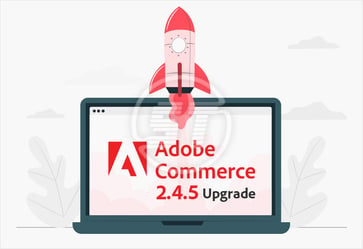Magento is a powerhouse ecommerce platform empowering many businesses with thriving digital stores built on it and optimized for a great customer experience. While you build a feature-rich and robust Magento store with flexible shopping carts, secure payment options, SEO optimization, another prominent factor that decides the success of your online store is your website performance. As you scale your website or build a robust product catalog, there could be a significant slip in the performance. A slow site is an indicator of a sinking business with a great dip in the conversion rate. This would affect your business by reducing customer retention and conversion rates.
If you have a Magento Store, then here are a few actionable tips that would boost the performance of your Magento store and improve your conversion rate.
1. Go for Powerful Hosting
The first step to improve the performance of your Magento store is to choose a powerful and fast hosting server. There are some cheap hosting plans readily available and may seem to be a better choice. But do not fall for it as it can dampen the functionality of your feature-rich Magento store. When you’ve invested in building a robust store that has the capability of garnering millions for you, why not make the first step right by choosing a good and dedicated hosting server having a high-speed connection, enhanced security mechanism, and quick support if there is downtime. While choosing the hosting server, check for uptime guarantees and reliability options.
2. Upgrade the Latest Version
As the latest updates are rolled out with new features and bug fixes, update your Magento swiftly for improved performance. Keep an eye on the latest update, check the release notes, and see the admin panel inbox for any update-related notifications. Always backup your data before you get the updated version. Choose a suitable time like the night when there is the least traffic to your Magento store.
3. Opt for High-quality Media
Multimedia elements like images and videos are crucial to the success of any ecommerce store as they fuel customer engagement in the desired manner. High-quality product images and video descriptions amplify the shopping experience of your customers and also boost up the SERP rankings. No ecommerce business survives without including high-quality product images showcasing the product in such a way that the prospective buyer goes through a real-time experience. While you choose high-quality images, you pay attention to the size of the images as it can impact the page load speed of your Magento store. So, compress the product images on the Magento store to deliver a faster website. You can also use a CDN for this purpose. There are also many Magento extensions available in the market to optimize the image sizes.
4. Setup a CDN
Delivering a high-speed browsing experience is the primary purpose of a Content Delivery Network (CDN). With the use of a CDN, you can load the pages of your store faster. It is typically a group of networks around the world in different regions serving diverse users and catering to the browsing needs of web users by efficiently delivering the content from the nearest location. This reduces the bandwidth consumption by a great deal and also improves the page load speed of your Magento ecommerce store. Suppose a user from New York accesses your website which is hosted in Ohio, with CDN implementation, the content delivery would be through the CDN server from New York itself, rather than delivering from the primary server, the one based in Ohio. This delivers a guaranteed faster experience to the website users.
5. Maintain Flat Catalog
Magento typically stores the catalog data in multiple database tables. This is based on the Entity-Attribute-Value (EAV) model wherein the data is stored in a normalized form and attributes in multiple tables. This is a time-consuming and complex process if you want to fetch the product details. So, go for a flat catalog that maintains just one table and clears the overheads of the EAV model by taking less DB space, improves query execution, and reduces the data fetch time.
6. Use Extensions Efficiently
The Magento extensions increase the functionality of your website. However, when you run an extension in your Magento store, it loads CSS, JS files, HTTP requests, affecting the store performance and page load speed. Have only those extensions that are necessary and serve your needs. Uninstall unused and unnecessary extensions. There are ready-made extensions available that can help the store owner to overcome the issues like high load time, cache delays, and other performance-related hassles. Tools like Full Page Cache, Google speed optimizer are a great way to up the speed and boost the performance. Image optimizations, advanced JS bundling, HTML & CSS minification, page speed monitoring is some of the services enabled by the Magento store extensions.
7. Optimize the Database
Database storage and retrieval are also crucial to improving website performance. A poorly optimized database is a mess and puts a load on the server. This results in shabby performance as it takes longer to serve. Go for a Magento site audit if you want to unravel any obscure issues that are sliding down your store performance. While retrieving the data from the database, use manual indexing. E-commerce is a dynamic business and the data (price, discounts, total amount, etc.) will be ever-changing and hence Magento reindex the data. Without reindexing, Magento has to calculate the price of every product with the applied discounts. This results in poor performance and ultimately leads to cart abandonment rates, a major pain point for any ecommerce merchants.
8. Enable Caching
Caching is probably the most popular option and the easiest way for Magento optimization. With Magento’s inbuilt caching mechanisms, you can improve the Magento site performance by speeding up the transfer of data and removing any performance bottlenecks. Caching improves performance by reducing the iterations of fetching the data every time from the server. The browser doesn’t need to reload the entire web page every time when the visitor makes a visit. This also reduces the server response time and bandwidth usage. With a plethora of caching mechanisms available on the Magento store, there is no way the performance of your Magento store going down. With Full Page Cache (FPC), you can retrieve and display the entire page in just a few microseconds. You should also use the Google page speed plugin to help the page load with the necessary speed.
9. Merge Files and Clean the logs
You can merge both the JavaScript and CSS files into one compressed file in the Magento store. With this, the content of your store can be retrieved by a single HTTP request. This not just saves the bandwidth but also improves the website performance. The latest version of Magento comes with a JS optimization and you can load the JS files after loading the main content. Magento also stores the logs for a period of 180 days and this is huge! Delete them and also choose the number of days for which you need to store the logs.
10. Reduce Time to First Byte
Time to First Byte (TTFB) determines how quickly your Magento website responds to browser requests. It is an indicator of how fast your Magento store is. Primary reasons for a slow TTFB are web server issues if the main server reaches its full capacity, slow commands due to DB optimizations. To inspect your website’s platform, there is a readily available built-in tool called Profiler that tweaks the Magento performance. There are a few other ways to reduce your Magento store’s TTFB. You can also use some online tools like Pingdom to find out what your TTFB is. The ideal TTFB would be under 1s. If it is more than that, it’s a sign of poor performance and you need to research to reduce it.
11. Use Eye-Catching Themes
An unoptimized theme could slow down the store and seriously impact the customer experience. However, choosing the theme is a challenge for store owners without the help of the Magento expert. If you are technically well-versed, then compare the technical features of all the available themes and choose the one that suits best for your business. Choose the template that comes up with the services and features required by the merchants. A well-optimized theme drastically reduces the need to have external plugins.
Closing Thoughts
You can follow the above checklist for Magento Performance Optimization to improve the website performance of the Magento ecommerce website. However, sometimes, it’s better to leave it to the trained professionals who have deep technical expertise to fix any issues and run your Magento store at peak efficiency at all times. They conduct a site audit to unravel any issues, fix them, and maximize your Magento store performance.
Magento is one of the best ecommerce platforms to drive more conversion rate and sales. But the implementation of above Magento Performance Optimization tips can boost your Magento store and leads to an improvement in sales. We provide end to end Magento store development services that will take your ecommerce business to new heights! Want to get more sales on your Magento ecommerce store on this holiday season? Hire our Magento Developers who have extensive knowledge and expertise in managing simple to complex Magento store!


